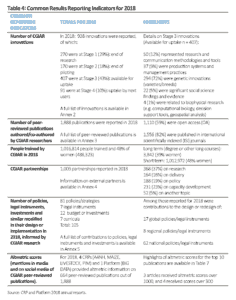CGIAR’s performance management system is structured around a conceptual framework that comprises three spheres that determine the extent to which there is control over research results and the contribution to development impact. This conceptual framework is presented in Figure 1, and further explained in Table 2.
The section “Progress towards the Sustainable Development Goals and CGIAR System Level Outcomes” of this report presents evidence linked to the sphere of interest. This section focuses primarily on the spheres of control (outputs) and influence of the performance management system, presenting evidence of progress towards research outcomes related to research use and effectiveness. Innovations, publications, training and partnerships refer to the sphere of control, and influences on policy and legal changes and investments and alternative metric (altmetric) scores relate to the sphere of influence.
GLDC 2018 annual report

Progress towards research outcomes are reported by the CGIAR Research Programs (CRPs) and Platforms in a narrative annual report (based on a common template) and with Common Results Reporting Indicators (CRRIs). These indicators were introduced in 2017 and include:
- The number of CGIAR innovations. Innovations are categorized in four stages: Stage 1: discovery/proof of concept; Stage 2: successful piloting; Stage 3: available or ready for uptake; and Stage 4: uptake by next user.
- The number of peer-reviewed publications authored or co-authored by CGIAR researchers.
- The number of people trained by CGIAR.
- The number of CGIAR partnerships.
- The number of policies, legal instruments, investments and similar modified in their design or implementation, informed by CGIAR research.
- Altmetric scores for publications.
Annexes 1, 2, 3, 4, 5 and 6 list the available data for the CRRIs for 2018. The numbers are summarized in Table 4.
For the first time in 2018, CRPs and Platforms are reporting their progress towards research outcomes using Outcome Impact Case Reports (OICRs). Table 2 presents the number of Outcome Impact Case Reports (OICRs) submitted in 2018 by CRPs and Platforms by level of maturity. It shows that 18% of OICRs were at a “level 3” stage of maturity in 2018; 34% of OICRs were at a “level 2” stage of maturity; and most OICRs in 2018 were at a “level 1” stage of maturity.

Table 3 presents 15 selected examples of OICRs for 2018 at maturity levels 1, 2 and 3. A full list of OICRs is available in Annex 1. An example of a level 2 OICR is the water planning data platform, “Agua de Honduras”, piloted and adopted by the Government of Honduras, which provides data on hydrology, vegetative cover, soil properties, along with future climate scenarios (WLE, 2018).
At level 3, an OICR reported by RTB documented a study on the release and adoption of improved sweet potato varieties in eight major producing countries in Southeast, South and East Asia. Data on varietal release showed that over a total of 434 varieties released, 195 (45%) had been adopted and cultivated, and that 45 of the 434 were CIP-related varieties. In 2015, the sweet potato cultivated area was 3.6 million hectares and 88% of this area was planted with improved varieties. 5% (164,000 hectares) of this area was planted with CIP-related varieties (RTB, 2018).

VIEW THE FULL LIST OF OICRS FOR 2018
READ MORE ABOUT CGIAR PORTFOLIO – PROGRESS REPORTED IN 2018




